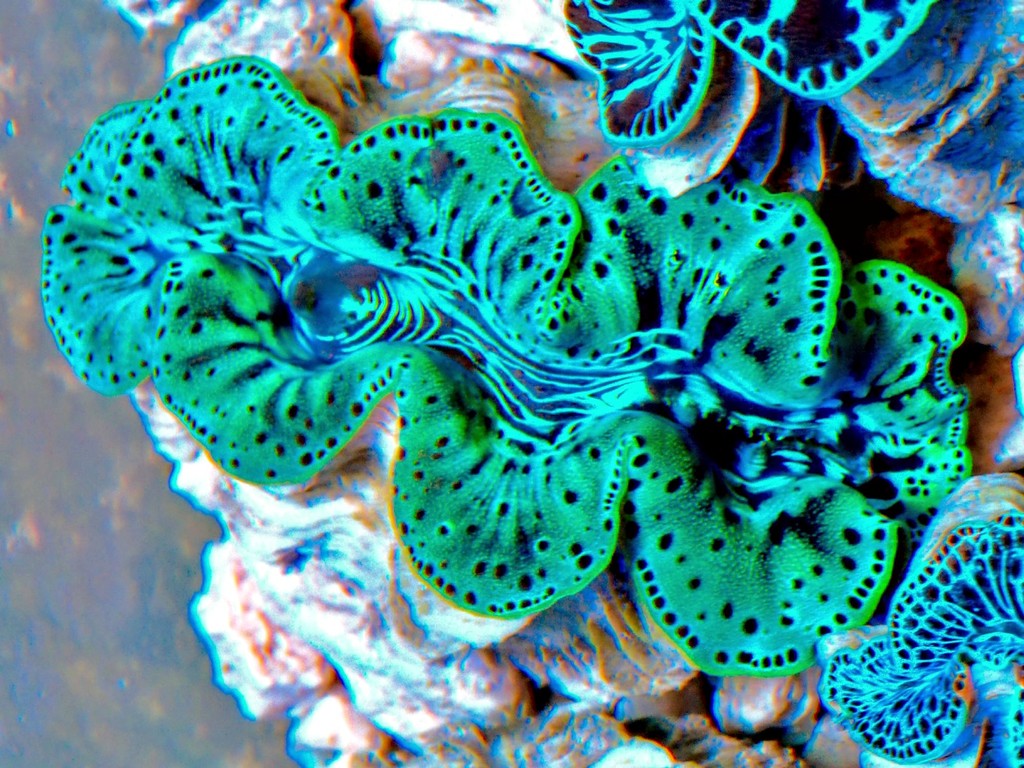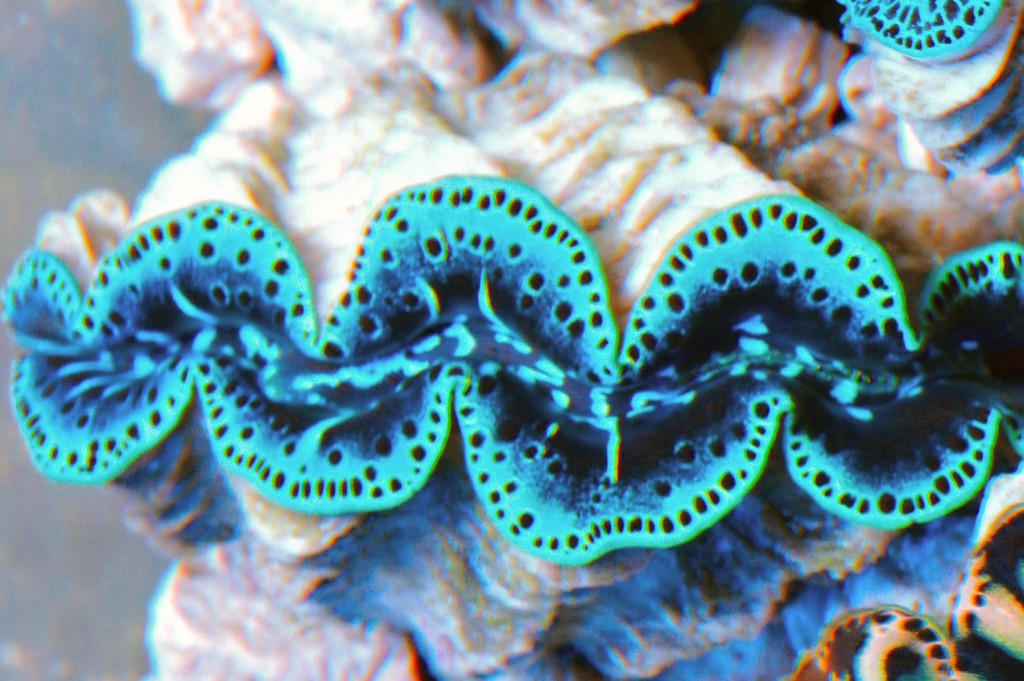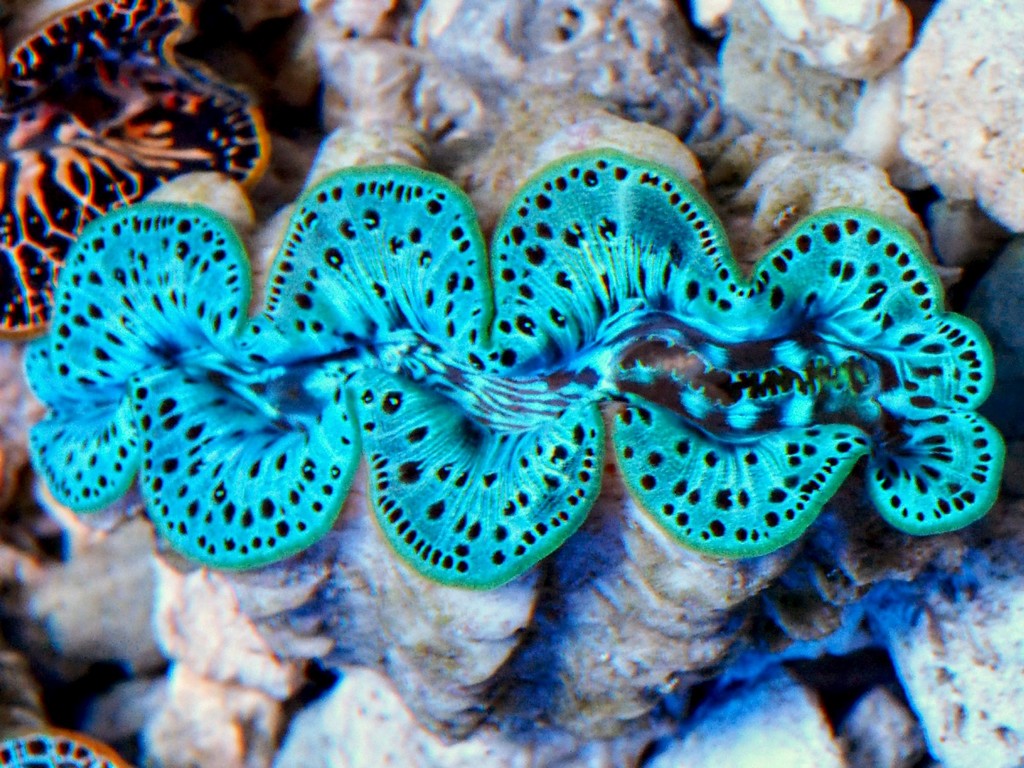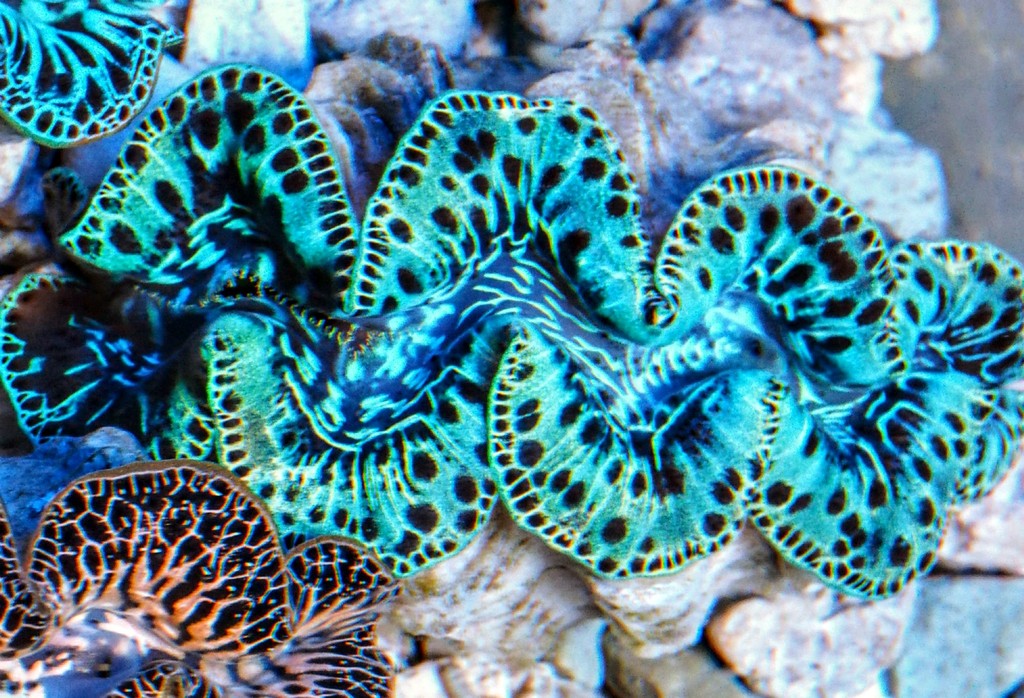Navigation
Install the app
How to install the app on iOS
Follow along with the video below to see how to install our site as a web app on your home screen.
Note: This feature may not be available in some browsers.
More options
You are using an out of date browser. It may not display this or other websites correctly.
You should upgrade or use an alternative browser.
You should upgrade or use an alternative browser.
WYSIWYG Clams
- Thread starter PacificEastAquaculture
- Start date
- Tagged users None
Users Who Are Viewing This Thread (Total: 1, Members: 0, Guests: 1)
All about 3 inches
Some are more blue, others more green, some are kind of turquoise, and still others are gold and a mix of crazy patterns. Regardless, they're all beautiful!
Our cultured Maxima Clams are actually quite easy to keep. They like lots of light but can be kept under a variety of lighting including most LED fixtures--we've had some over 4 years in a small cube display tank that has an old crappy LED fixture and they are doing great next to crazily growing Acros, Montis, chalices, and more.
They need a firm surface to attach their foot to so place them on the rocks where they won't fall over or on the sand with rock rubble or a clam cradle underneath. These are cultured clams, but in the wild Maxima clams are found embedded in rock so be sure they have a firm surface to attach to, it is naturally how they live and also prevents pests from entering through the vulnerable foot. A healthy normal clam should attach to a firm surface within about 24 hours. We keep the cultured clams on small gravel or rubble so we can easily ship them without damaging the foot so when you receive them you may see some rubble on the foot or in the bag.
They do best in tanks that are not too pristine. Tanks that have a heavier well fed fish population that has some measurable amount of dissolved organics are best. Our cultured clams are all about 3 inches or so and at this size do not and should not be specifically fed. They live off the products of photosynthesis and from utilizing dissolved organics.
Be sure to house them with fish that won't nip at them. It's common to see nips and healed bites on the mantles of wild or even ocean cultured clams, they're tasty snacks for lots of fish. In your tank if you don't want to provide an expensive meal try to avoid most butterflyfish, angelfish, triggers, and some tangs, there are many potential predators but most commonly known reef safe fish will usually ignore your clams. Fish do change their tastes over time. I once had a large emperor Angel that devoured a clam in a mixed reef, years later I added a new clam and it totally ignored it for several years--so it's difficult to predict with specific fish.
Most cultured clams are free from pests, but not always, most wild clams do have pests. Small pyramid snails, aiptasia, and many other pests can infest clams. When obtaining any clam from any source it is always best to brush clean the shell with a soft bristle toothbrush being careful to not damage the mantle or foot. Then be sure to quarantine any new additions in a separate tank for at least 2 weeks before adding to your display tank. During quarantine be sure to observe and check constantly. Quarantine in itself is only effective if you check for pests and deal with them if present. Some folks advocate freshwater dips for clams. This can be done but is very stressful to the clam and should be used as a last resort. In the past it was used on wild clams, but is not usually needed for cultured clams. If you notice so-called pinched mantle--an unusual folding in the mantle--you can try dipping in a freshwater bath with purified freshwater of the same temperature and pH of your tank, put the clam in the freshwater for up to 10 minutes then return it back to the tank. The dip can be done every 2 days if needed. However, usual by the time visible signs are seen the clam is usually too far gone to save. Some folks advocate keeping certain wrasse with clams to help control pyramid snails and other pests. Small wrasse such as sixline or melanurus can be helpful, but on occasion have been observed picking at the mantle so be observant and react as needed.
Dr. Mac went to French Polynesia many years ago and helped set up a clam farm there. The process involved meeting with the President and legislature to change laws prohibiting export of clams smaller than 4.5 inches. There are hundreds of millions of Maxima Clams in French Polynesia around the islands distant from Tahiti. Clams are used as a food source and Maxima clams can be purchased in local food stores by the pound wrapped in plastic bags, minus the shell of course. Some small islands are made entirely of old clam shells! The waters in many areas where we find large clam populations are clear and cold, often in the high 60s, and all clams are found embedded in rock about 2 to at most 8 feet below the surface. The water flow is strong. In some other areas clams are so plentiful that they are growing on all surfaces and can be seen in every direction for as far as your eyes can focus. Maxima clams are very plentiful in the wild. However, these wild clams are much more difficult to collect without damaging the foot and must be a minimum of 4.5 inches to export. A clam that size is 5 plus years old and use to living in its very specific environment, and not likely to adapt well to being collected from a remote island unless its handled gently and conditioned before export, shipped completely dry to the main island, then shipped to the US and then kept under a completely different environment all within a few days from when it was basking on a remote reef under blazing tropical sunlight. In the past we imported and sold many of these wild clams in the early years as the farmed clams were developing and in the beginning they did very well because we carefully hand collected every clam and cinditioned them for weeks before export. You can see videos of our facility here in Maryland when we had over 1000 of these clams in stock, they were beautiful and losses were very rare in those early years. Later as the popularity of fish from the same locations increased dramatically the local collectors that had been so careful collecting and conditioning wild clams now turned their focus to fish collection and then turned over clam collection to the divers collecting the clams for food and sadly damaged the foot and stopped shipping the clams in water and instead sent them from the remote islands dry then quickly turned them over and did not condition them before export. We stopped selling the wild clams a few years ago and started stocking only the cultured ones as the farm became mature and productive, but they are not as regularly available so you may not see them on our site frequently. The cultured clams are raised in protected areas in shallow waters in the ocean. As the seasons change the temps can get very high in these shallow waters and this stresses the clams and we don't ship them at those times. So this is why you don't see the cultured clams on our site constantly. When we do get them, when the season allows, we get large quantities and they arrive from their journey from Tahiti to Maryland in perfect condition with zero losses. Enjoy them while they're here!

Our cultured Maxima Clams are actually quite easy to keep. They like lots of light but can be kept under a variety of lighting including most LED fixtures--we've had some over 4 years in a small cube display tank that has an old crappy LED fixture and they are doing great next to crazily growing Acros, Montis, chalices, and more.
They need a firm surface to attach their foot to so place them on the rocks where they won't fall over or on the sand with rock rubble or a clam cradle underneath. These are cultured clams, but in the wild Maxima clams are found embedded in rock so be sure they have a firm surface to attach to, it is naturally how they live and also prevents pests from entering through the vulnerable foot. A healthy normal clam should attach to a firm surface within about 24 hours. We keep the cultured clams on small gravel or rubble so we can easily ship them without damaging the foot so when you receive them you may see some rubble on the foot or in the bag.
They do best in tanks that are not too pristine. Tanks that have a heavier well fed fish population that has some measurable amount of dissolved organics are best. Our cultured clams are all about 3 inches or so and at this size do not and should not be specifically fed. They live off the products of photosynthesis and from utilizing dissolved organics.
Be sure to house them with fish that won't nip at them. It's common to see nips and healed bites on the mantles of wild or even ocean cultured clams, they're tasty snacks for lots of fish. In your tank if you don't want to provide an expensive meal try to avoid most butterflyfish, angelfish, triggers, and some tangs, there are many potential predators but most commonly known reef safe fish will usually ignore your clams. Fish do change their tastes over time. I once had a large emperor Angel that devoured a clam in a mixed reef, years later I added a new clam and it totally ignored it for several years--so it's difficult to predict with specific fish.
Most cultured clams are free from pests, but not always, most wild clams do have pests. Small pyramid snails, aiptasia, and many other pests can infest clams. When obtaining any clam from any source it is always best to brush clean the shell with a soft bristle toothbrush being careful to not damage the mantle or foot. Then be sure to quarantine any new additions in a separate tank for at least 2 weeks before adding to your display tank. During quarantine be sure to observe and check constantly. Quarantine in itself is only effective if you check for pests and deal with them if present. Some folks advocate freshwater dips for clams. This can be done but is very stressful to the clam and should be used as a last resort. In the past it was used on wild clams, but is not usually needed for cultured clams. If you notice so-called pinched mantle--an unusual folding in the mantle--you can try dipping in a freshwater bath with purified freshwater of the same temperature and pH of your tank, put the clam in the freshwater for up to 10 minutes then return it back to the tank. The dip can be done every 2 days if needed. However, usual by the time visible signs are seen the clam is usually too far gone to save. Some folks advocate keeping certain wrasse with clams to help control pyramid snails and other pests. Small wrasse such as sixline or melanurus can be helpful, but on occasion have been observed picking at the mantle so be observant and react as needed.
Dr. Mac went to French Polynesia many years ago and helped set up a clam farm there. The process involved meeting with the President and legislature to change laws prohibiting export of clams smaller than 4.5 inches. There are hundreds of millions of Maxima Clams in French Polynesia around the islands distant from Tahiti. Clams are used as a food source and Maxima clams can be purchased in local food stores by the pound wrapped in plastic bags, minus the shell of course. Some small islands are made entirely of old clam shells! The waters in many areas where we find large clam populations are clear and cold, often in the high 60s, and all clams are found embedded in rock about 2 to at most 8 feet below the surface. The water flow is strong. In some other areas clams are so plentiful that they are growing on all surfaces and can be seen in every direction for as far as your eyes can focus. Maxima clams are very plentiful in the wild. However, these wild clams are much more difficult to collect without damaging the foot and must be a minimum of 4.5 inches to export. A clam that size is 5 plus years old and use to living in its very specific environment, and not likely to adapt well to being collected from a remote island unless its handled gently and conditioned before export, shipped completely dry to the main island, then shipped to the US and then kept under a completely different environment all within a few days from when it was basking on a remote reef under blazing tropical sunlight. In the past we imported and sold many of these wild clams in the early years as the farmed clams were developing and in the beginning they did very well because we carefully hand collected every clam and cinditioned them for weeks before export. You can see videos of our facility here in Maryland when we had over 1000 of these clams in stock, they were beautiful and losses were very rare in those early years. Later as the popularity of fish from the same locations increased dramatically the local collectors that had been so careful collecting and conditioning wild clams now turned their focus to fish collection and then turned over clam collection to the divers collecting the clams for food and sadly damaged the foot and stopped shipping the clams in water and instead sent them from the remote islands dry then quickly turned them over and did not condition them before export. We stopped selling the wild clams a few years ago and started stocking only the cultured ones as the farm became mature and productive, but they are not as regularly available so you may not see them on our site frequently. The cultured clams are raised in protected areas in shallow waters in the ocean. As the seasons change the temps can get very high in these shallow waters and this stresses the clams and we don't ship them at those times. So this is why you don't see the cultured clams on our site constantly. When we do get them, when the season allows, we get large quantities and they arrive from their journey from Tahiti to Maryland in perfect condition with zero losses. Enjoy them while they're here!

Still some absolutely gorgeous and hardy clams available, you can get WYSIWYG or try our popular "Our Puck" specials, see them here:
https://www.pacificeastaquaculture.com/prodList.asp?idcategory=3&pMaxItemsPerPage=1000

https://www.pacificeastaquaculture.com/prodList.asp?idcategory=3&pMaxItemsPerPage=1000

Great, thanks for the feedback. Keep them under the water when you put the in and "burp" them once they're in by rocking them gently back and forth to dislodge air bubbles that could get trapped. Keep us updated on how they do for you please.
Get your WYSIWYG clams before they're all gone!
See them here:
https://www.pacificeastaquaculture.com/Clams-for-Sale-Maxima-Crocea-Squamosa-Deresa-Prodlist.html

See them here:
https://www.pacificeastaquaculture.com/Clams-for-Sale-Maxima-Crocea-Squamosa-Deresa-Prodlist.html

Excellent quality, hardy and easy to keep, try our cultured Polnesian Maximas !

WYSIWYG and "Our Pick" specials available:
https://www.pacificeastaquaculture.com/Clams-for-Sale-Maxima-Crocea-Squamosa-Deresa-Prodlist.html

WYSIWYG and "Our Pick" specials available:
https://www.pacificeastaquaculture.com/Clams-for-Sale-Maxima-Crocea-Squamosa-Deresa-Prodlist.html
- Joined
- Apr 9, 2020
- Messages
- 31
- Reaction score
- 16
All of your clams are absolutely beautiful! I love that they are all WYSIWYG! However, I REALLY wish you offered croceas because maximas just grow too large for my little nano tank ;Sorry
Similar threads
- Replies
- 12
- Views
- 497
- Replies
- 2
- Views
- 278
- Replies
- 12
- Views
- 837
- Replies
- 5
- Views
- 728









